Our friends at Soundfly have done an exhaustive breakdown of the musical structure and composition behind every song from the year that cracked the Billboard Top 5, revealing more than a few Drakes.
_______________________________
Guest post by Dean Olivet of Soundfly’s Flypaper
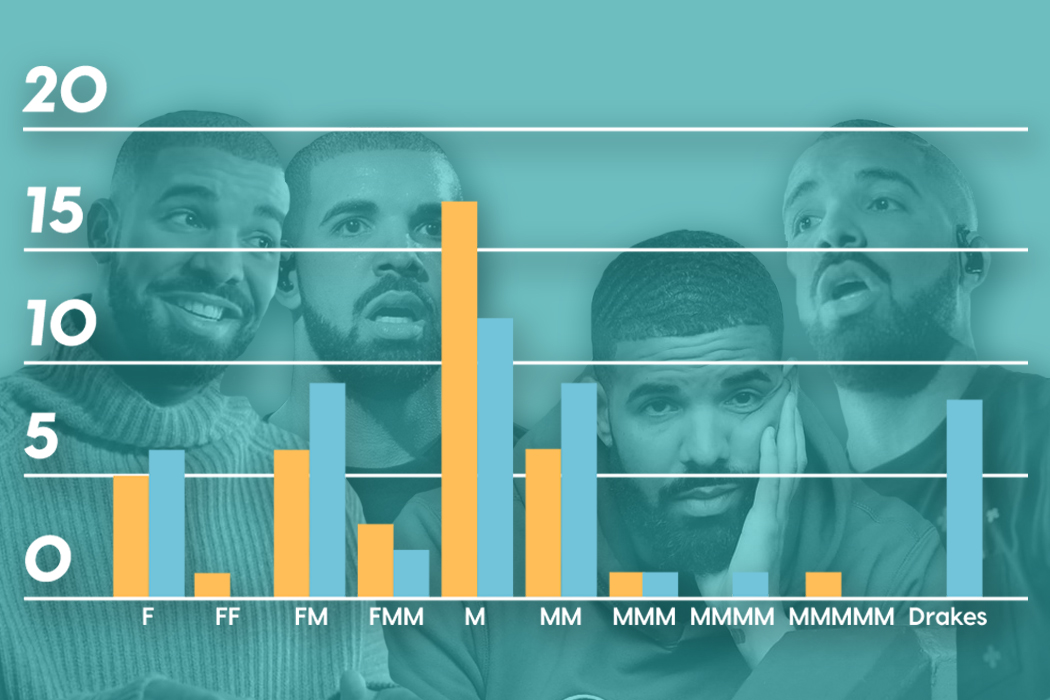
Welcome back, pop music scholars, and Look Alive… because we did it again.
That’s right — we sent an even Better Now, out-of-this-WRLD probe past all the FEFE’s and ZEZE’s that were Meant to Be in the Top 5 of 2018’s Billboard Hot 100 charts, and what we got back was a tally of data and stats Grande enough to satiate all you Nonstop audiophiles’ consonance curiosity. Nice for What? Nice for showing any Childish Young Bunny how to craft a song XXXTensive enough to bang its way into a Top 40 slot, next year and beyond.
Speaking of Top “40,” that’s literally what this year’s list totaled (all by itself this time!). Yep, there were 40 songs “Boo’d Up” in the Billboard’s Top 5 in 2018. Exactly 40 — how clean is that?
Just like last year, our master song specs charts are up first, including: 2018’s trendiest tonalities, keys, tempos, meters, triads, song lengths, chord totals, form sections, and singer genders (compared, of course, to the number of times Drake himself shows up in this list). And below all these veritable knowledge bombs, you’ll be amazed to find individual stats and commentary for all 40 songs!
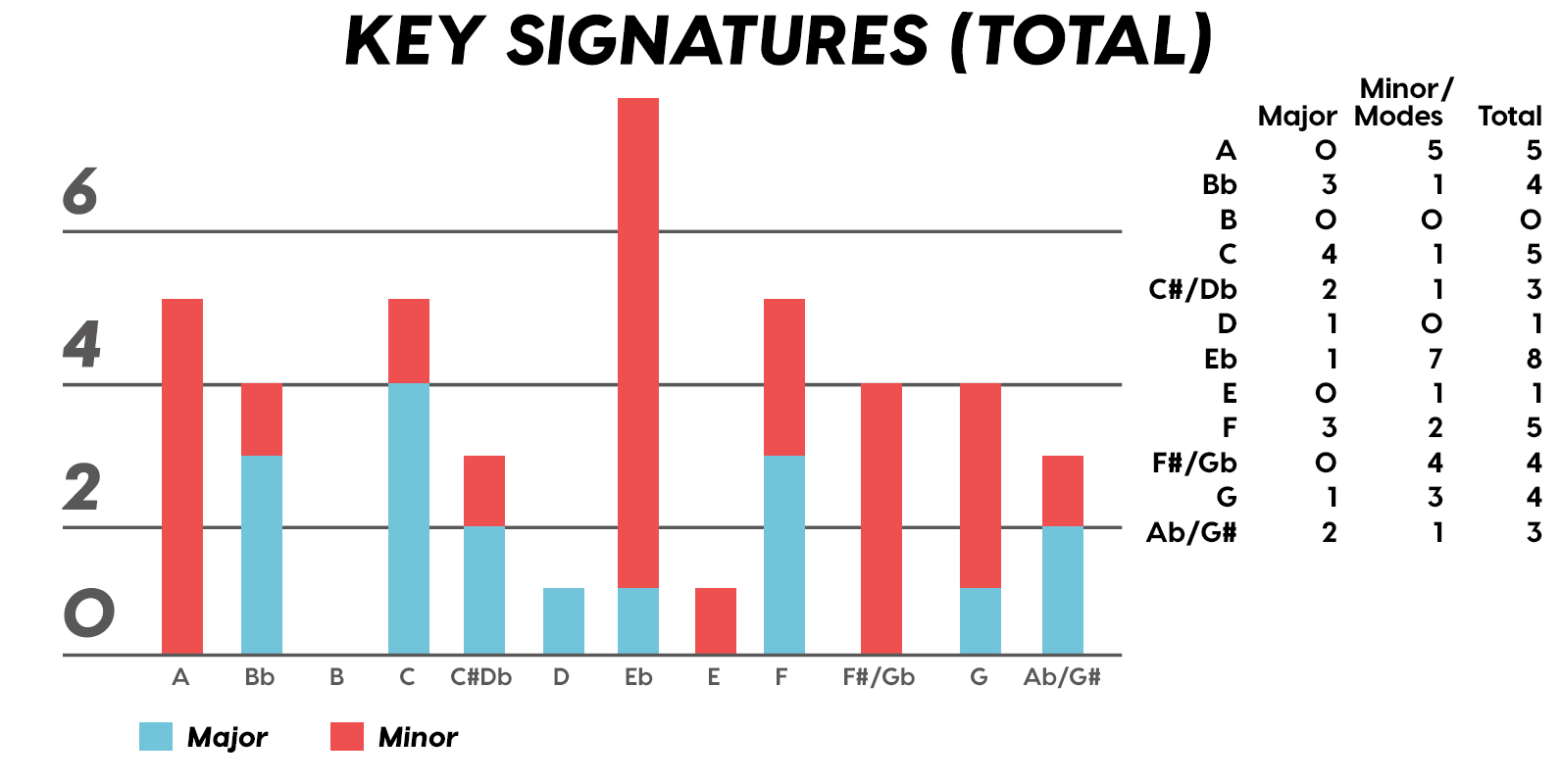
“To B, or not to B.” That is… not a question this year, because none of our songs were in the key of B! It was E♭— minor, specifically — that was our huge winner this year (black keys on the piano in general, really), with low showings for the keys of D and E, once again proving that nobody writes Top 40 pop songs on their guitars anymore.
Since we had some Lydian keys this year, and Lydian is technically a major mode, I lumped these songs in with the major column — above, at least. Below you can see these separated out.
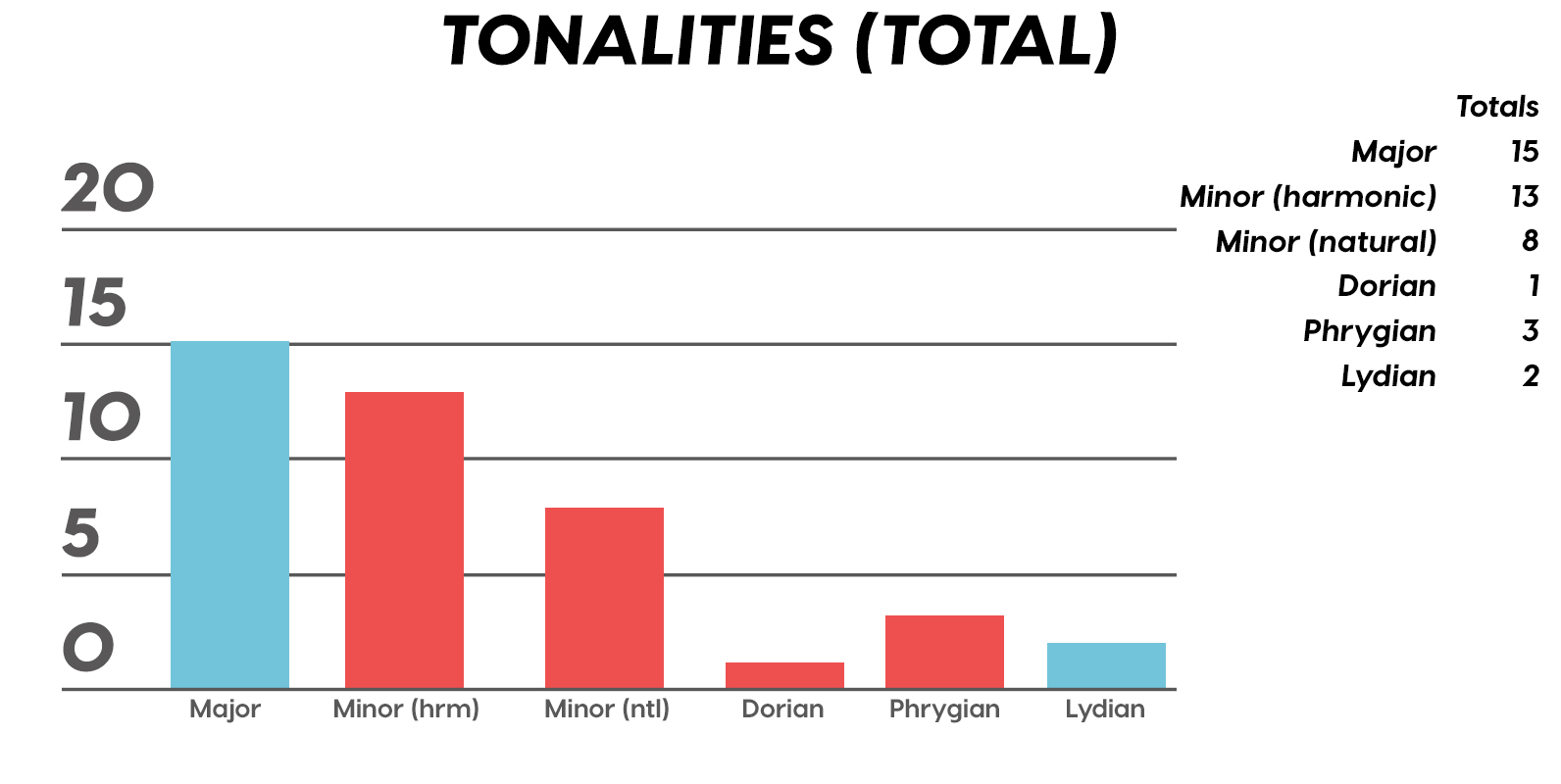
Very similar tonalities used this year, as compared to 2017. The major mode gained a little ground this year, chalking one more song, but it’s those sneaky-sultry minor modesthat are still dominating. Worth a shout are the upticks in Lydian and Phrygian, and it’s also interesting that harmonic minor scales doubled their representation from four songs to eight. Maybe the V chord is coming back in style after all?
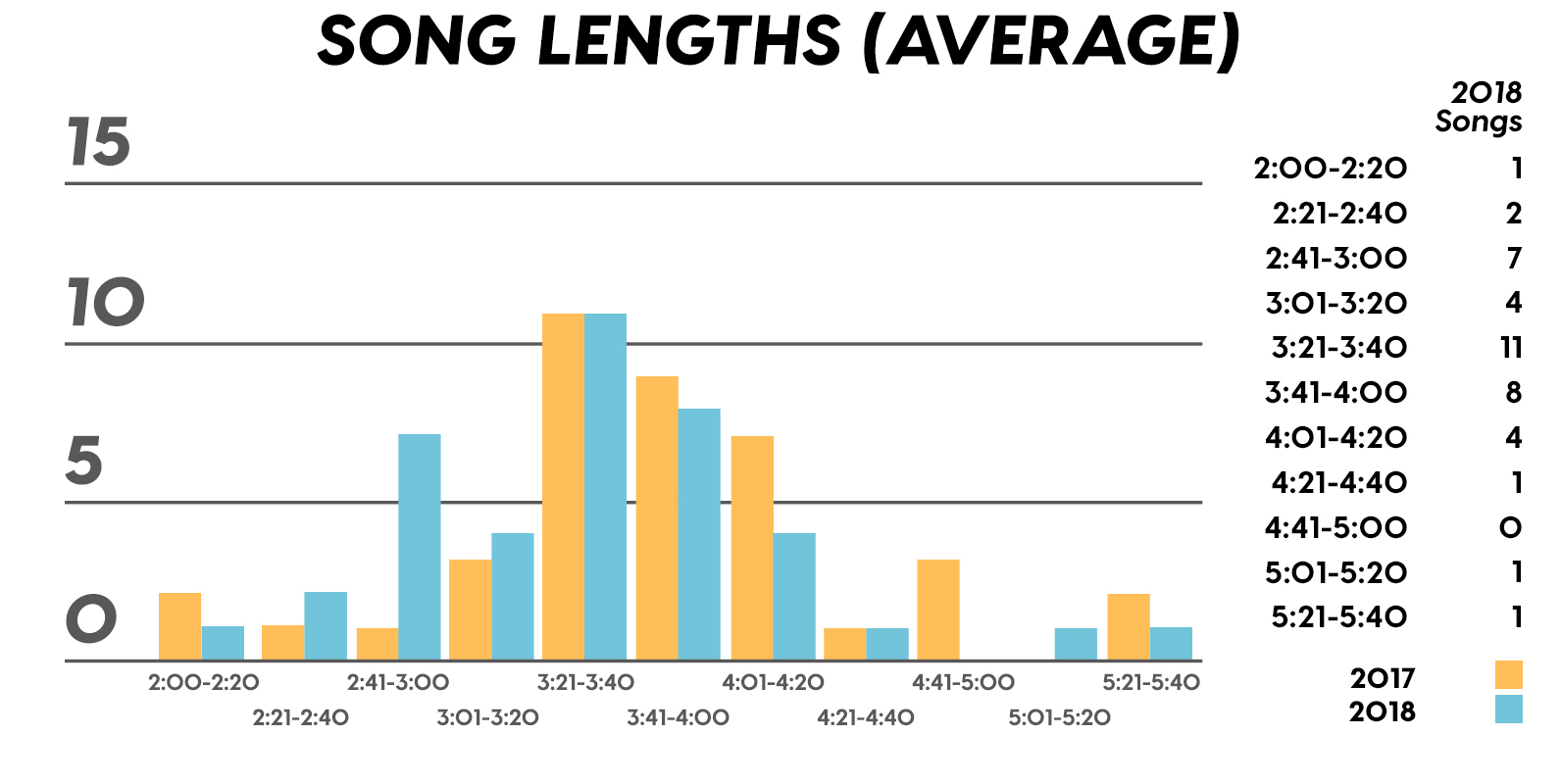
Similar to last year, songs lasting between 3:21-3:40 remain on top. The most improved category is the 2:41-3:00 song, increasing its presence sevenfold! And, as long as we’re talking songs and lengths of things, can we talk about Drake already? This is like the seventh paragraph and we still haven’t mentioned the length and breadth of Drake’s magnum double-album opus, Scorpion.
The week his shipping container of beats and buddies dropped (Billboard week of July 14), His Eminent Drakiness had 22 — spell it out: twenty-two effing tracks — that made the Billboard Hot 100 that week. The lowest of which appeared at #57!
What’s this have to do with song lengths? Mainly, this unheard-of achievement outlines, among other things, that song lengths, album lengths, and music video lengths just don’t matter as much anymore. Why?
Because of streaming, because of fancy new Corolla dashboards that talk to you and stuff — that’s why. No, radio is not dead. Not yet, at least. But when you can listen to basically whatever you want, whenever you want, without going to the record store with a million bucks, you know that the days when songs-for-the-masses had to be on the shorter side and, I don’t know, be by different people — yeah, those days are gone.
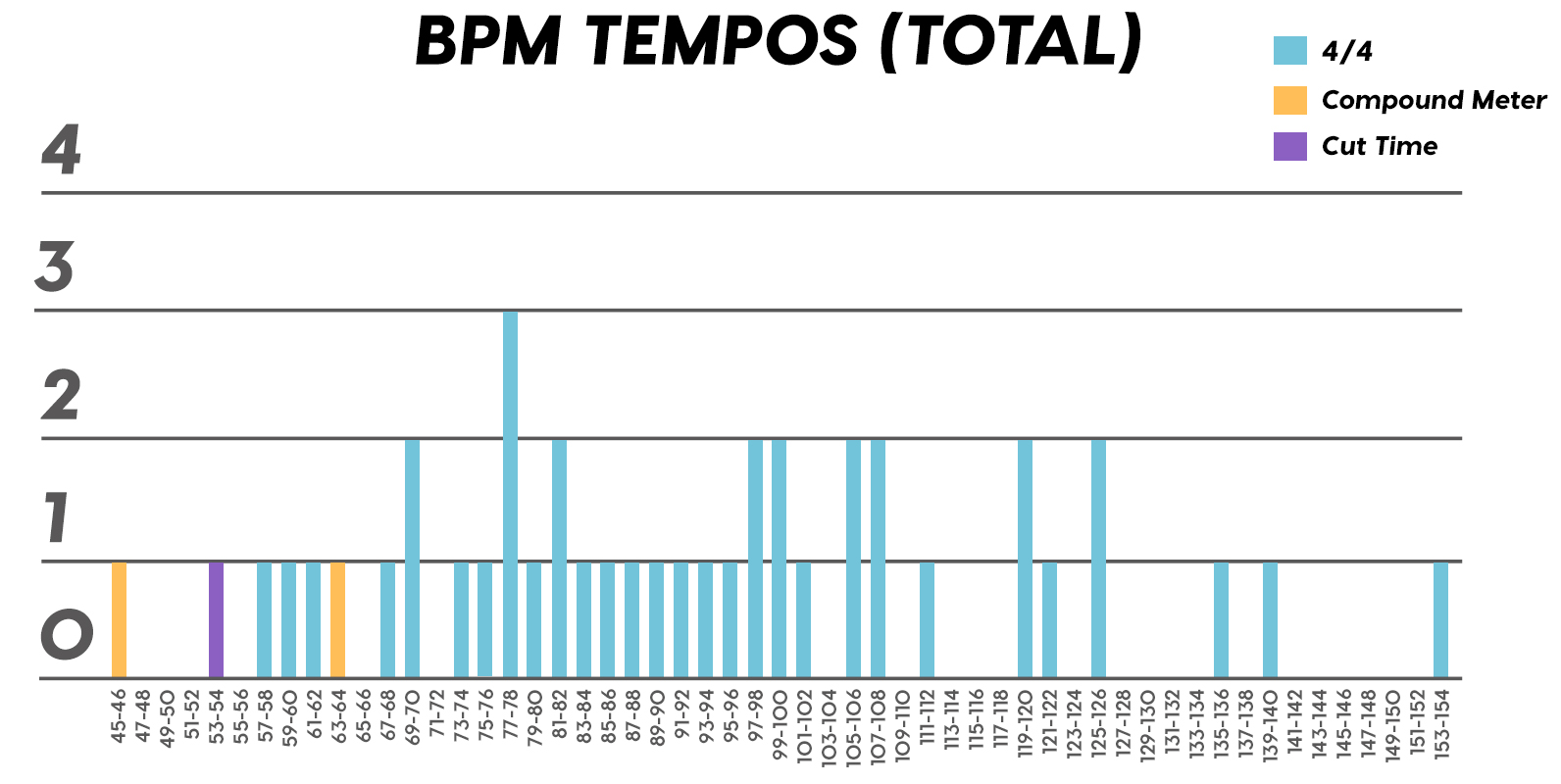
Looks like a pretty even tempo spread this year with 77-78 BPM eeking out a win. From 71-72 BPM there is still a gap in the chain, similar to last year, and from 113-118 BPM is still a very curious drought-land, at least when compared to all the tempos found in Rolling Stone’s Greatest 500 Songs of All Time list.
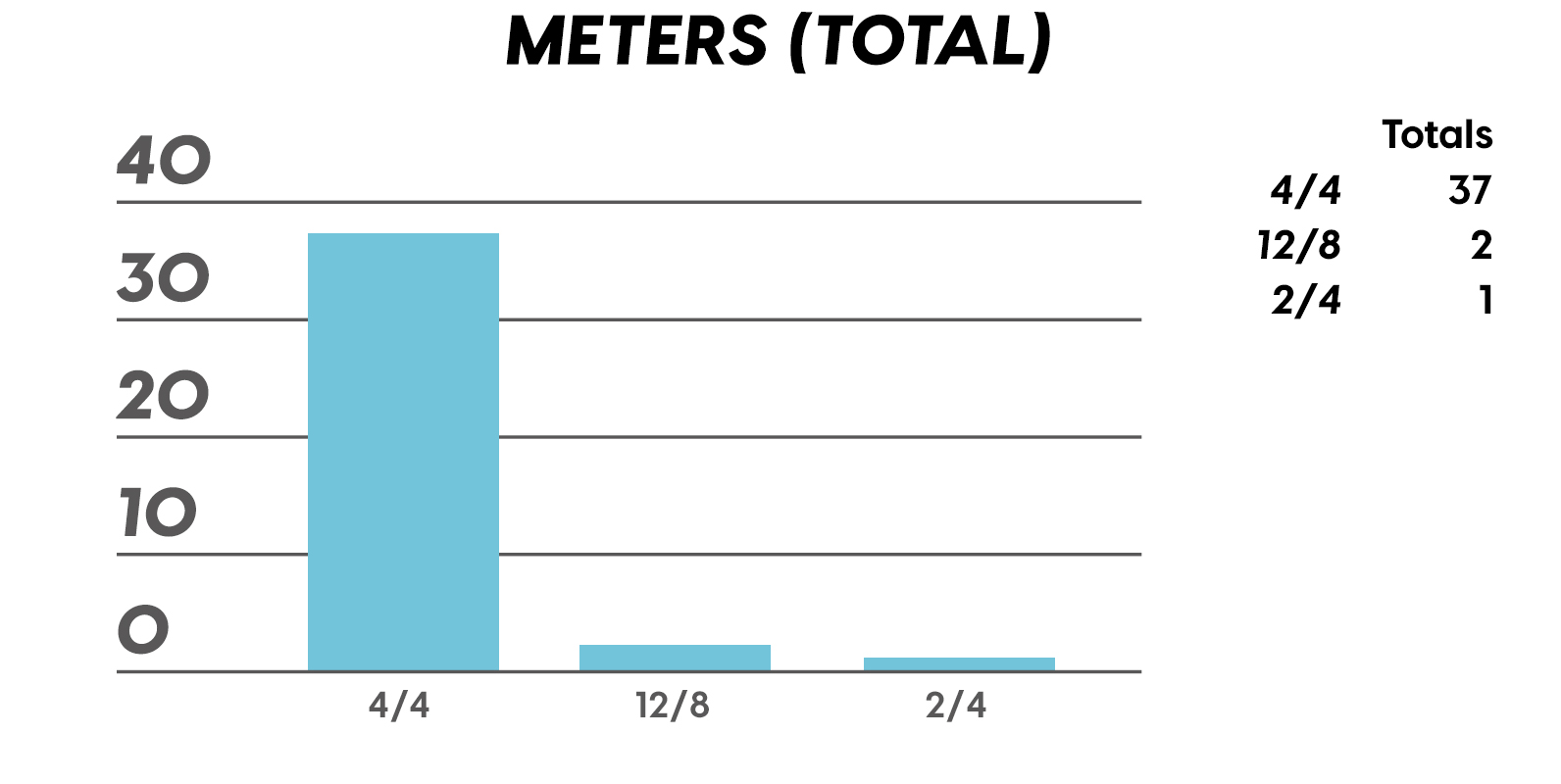
I’m not sure if it’s interesting or anti-interesting that our meter chart matches almost exactly with last year’s, at thirty-seven 4/4s, two 12/8s, and instead of the uncommon gatling gun 24/16, we found a somewhat-rare-in-its-own-right 2/4 meter.
3/4 time is still at large — anyone with information as to its whereabouts please contact: The Pianoman at 555-Lala-didada-dadum.
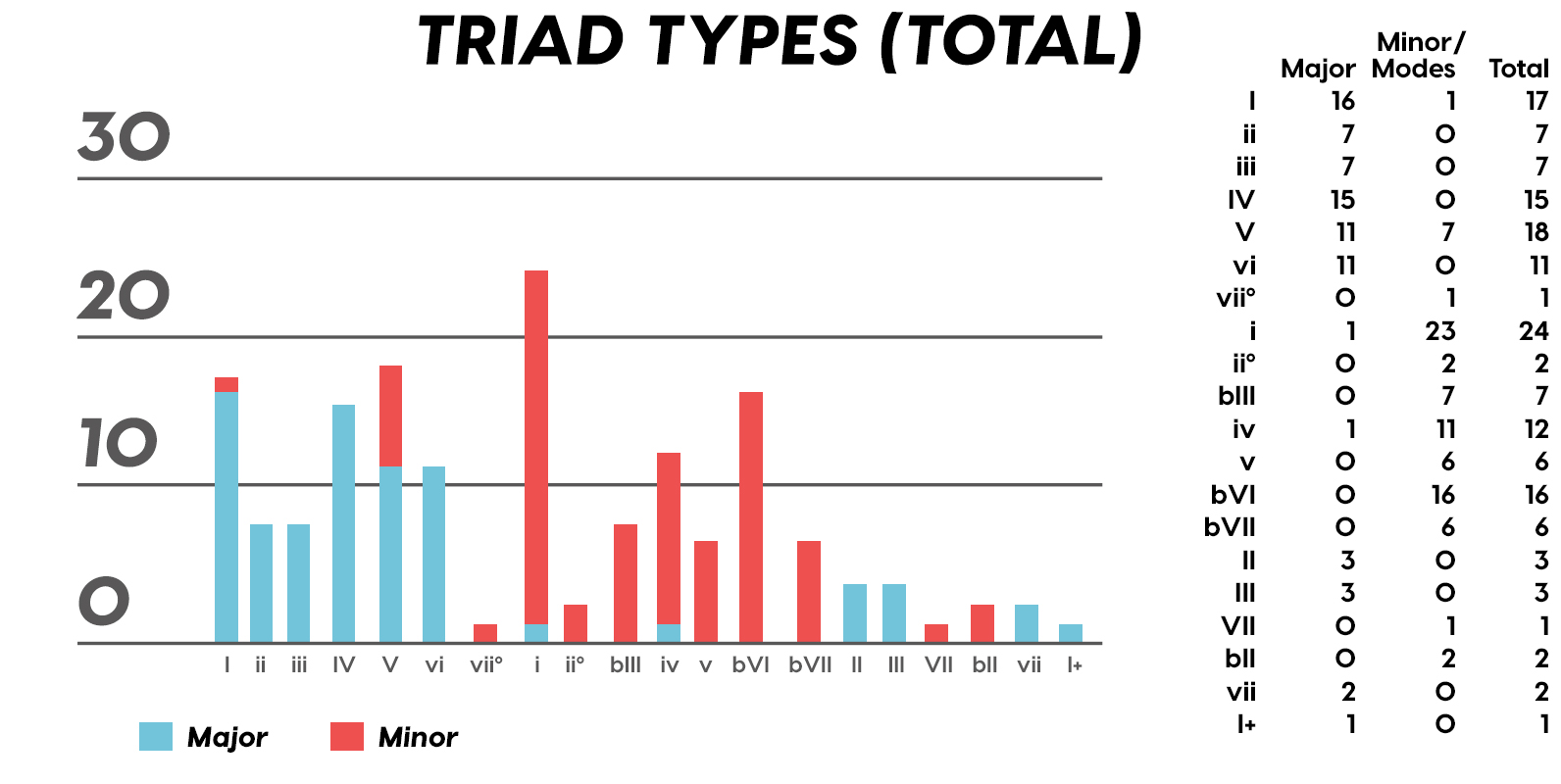
Now let’s look at some anomalies for roman numeral chord types used. For instance, the iii and♭VII chord types appeared well above and below their average rates, respectively, and both the major and minor tonalities managed to borrow their opposite tonics, so that’s a fun spice you don’t often get to taste.
Also, as our♭II chord types were technically diatonic (aka “regular”) to the Phrygian mode, our non-borrowed-or-secondary weirdo-chords this year were the viis (when it was once a ii/V/♭VI and once diatonic to Lydian) and also a I+ (augmented).
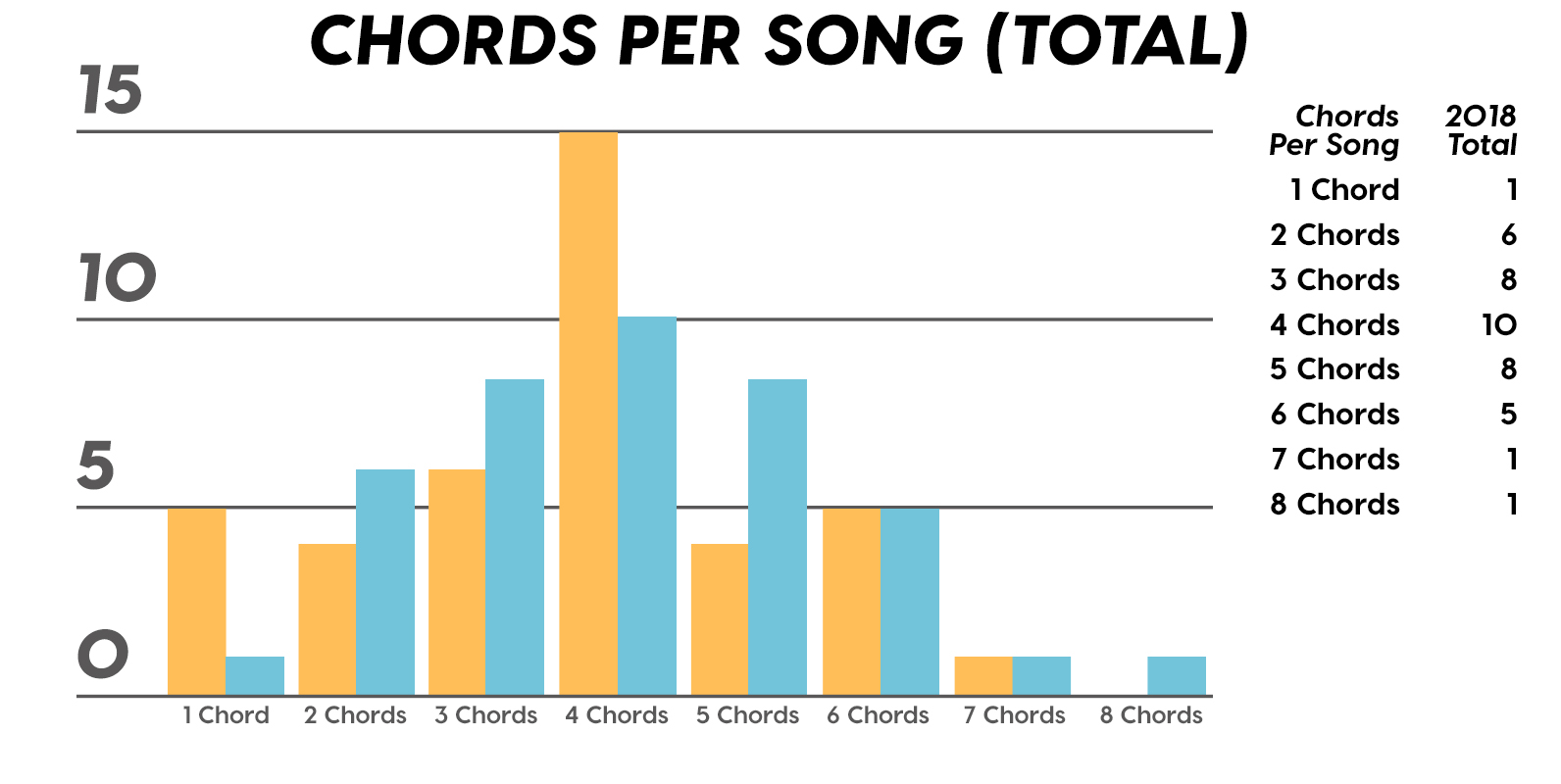
Here we see that we’ve flattened out into a bit more of a bell curve rather than that middle-finger looking thing from 2017, with the four-chord song still being the norm. Panic! at the Disco threw some jazzy borrowed and secondary chords our way and pushed the collective envelope one column further than 2017, with an all-out eight-chorder.
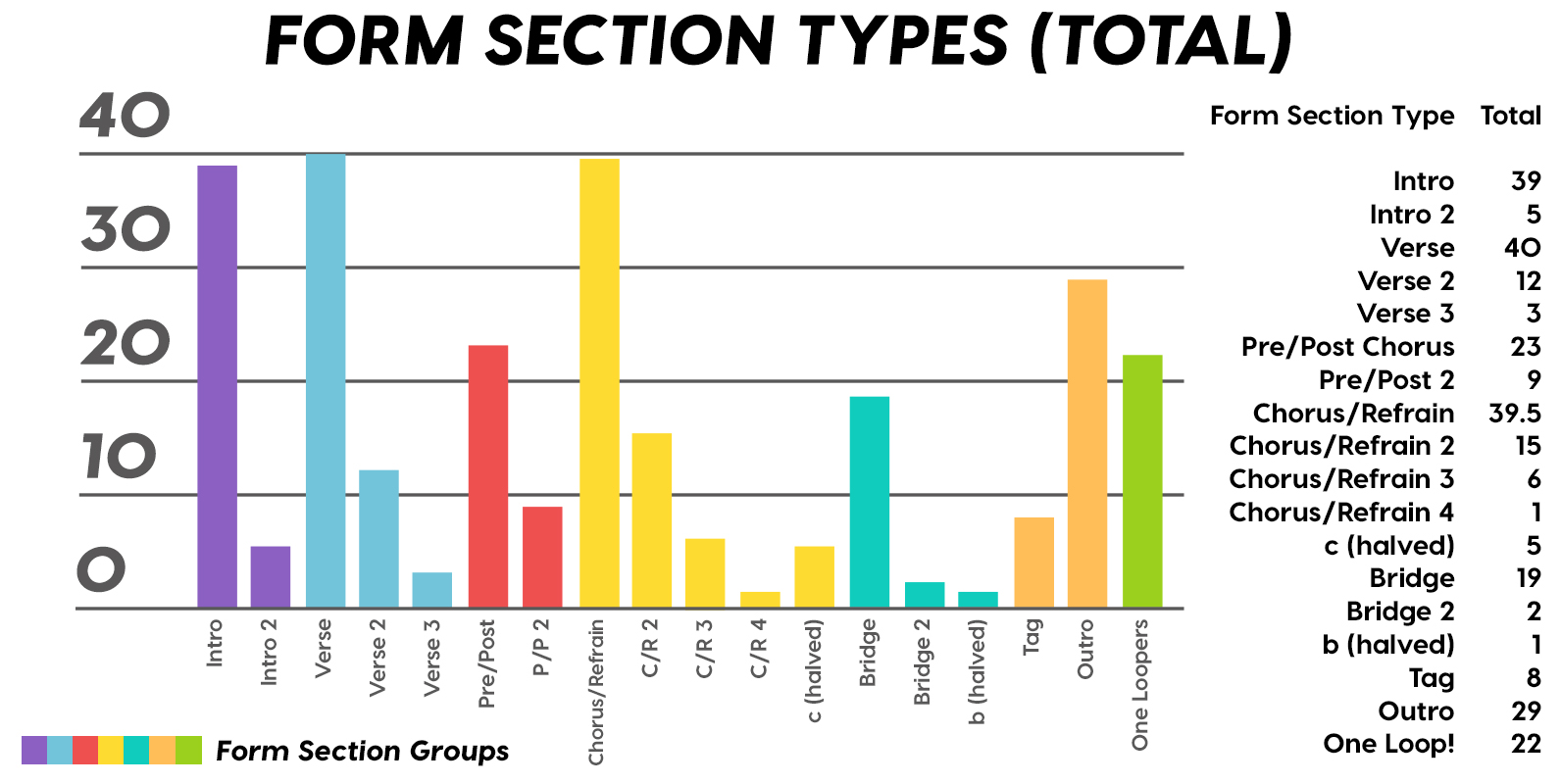
Pre- and post-choruses were a little less aggressive this year, even while variations on these chorus-abutting sections saw an increase. Interestingly, only “The Middle” dispensed with any intro material this year, and only Eminem’s “Killshot” got into the Top 5 without any chorus or refrain material, but I mean, he did say right at the start of the song that he wasn’t gonna repeat himself, so there you have it. (And yes, I said “chorus-abutting sections” back there, and yes, I had Morgan Freeman’s voice in my head when I said it … “chorus-abutting sections.“)
Oh! And look up over there on the right. I’m very excited to share with you a new statistic I collected this year. Would you believe that 22 songs out of 40 were based off of just one single loop only (loop variations allowed)? That’s more than half. You may now commence to argue over how uncreative music is these days, or over how Einstein really did prove that “less is more.”
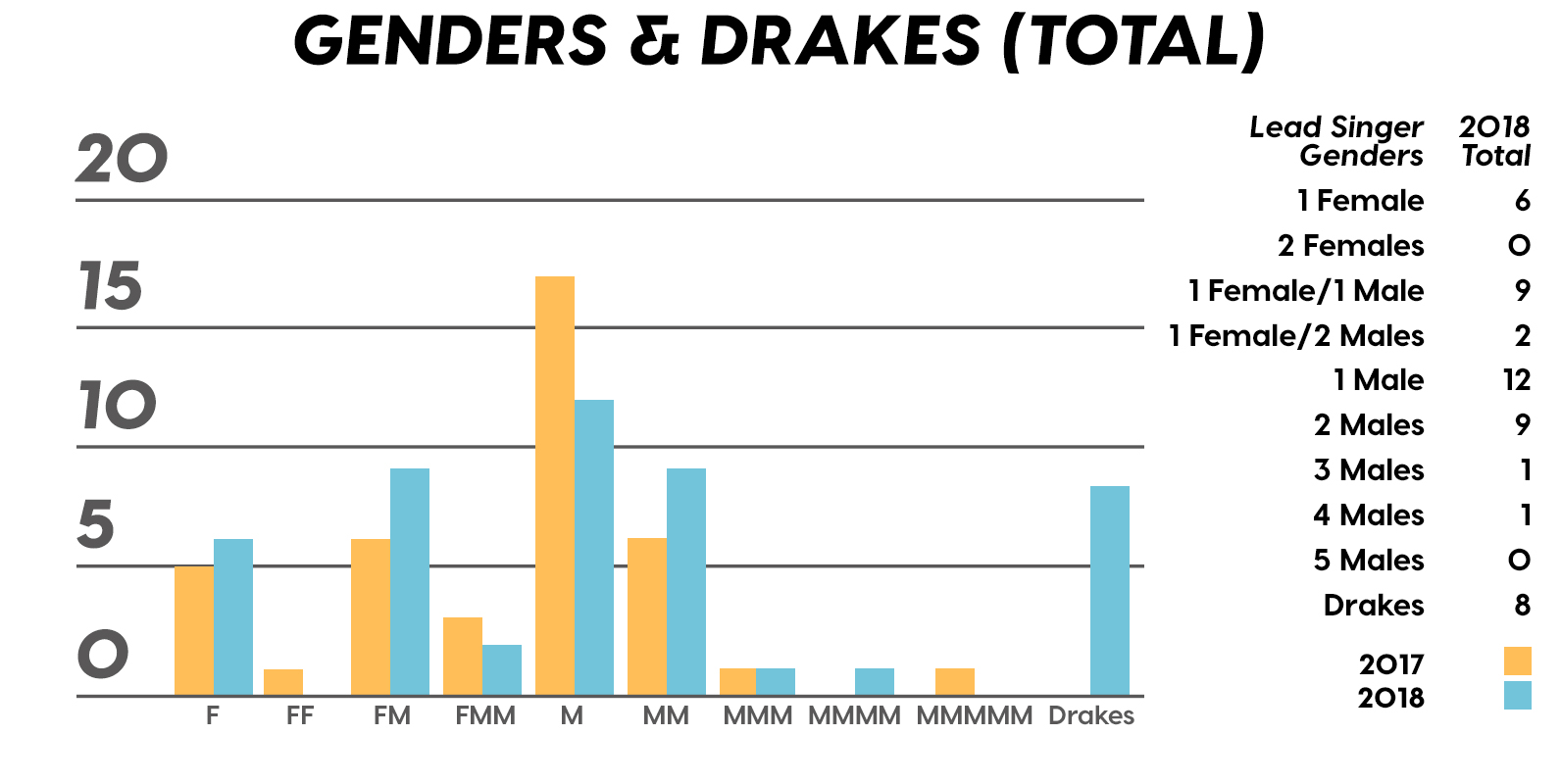
I’m sorry to report that women artists didn’t gain much ground this year. And even though male-female duets saw a healthy bump, not even one strictly female duet showed up to the party, while a full third of our 2018 “Top 5-ers” had at least two dudes in the room! I don’t know, maybe blame it on the surplus of Drakes lying around?
Alright, well, there you have it: 2018’s Billboard Chartmania! Happy New Year!
One chart taught me love / one chart taught me patience / one chart taught me pain / this is amazing / thank u, next / I’m so freaking grateful for these pop-song specs.
Next up, it’s the lowdown on all 40 songs, ordered by weeks at #1, then on down to weeks in the Top 5 in descending order. So we start with the king of 2018.

Form: I(4) – V(8) – C(8) – P(8) – V2(8) – C2(8) – P(8) – O(12)
“God’s Plan”: Man, the chords in this loop were hard to identify. Not only because the notes here don’t conform to standard A-440 tuning (it’s all about 20 cents sharp of G major), but because they start out as ninth chords whose upper halves are louder and more timbre-distinct than their lower, arpeggio-happy halves. It’s almost like it’s better explained not as “9-chords,” but as “an Em stacked on top of an Am,” and then “a D chord stacked on a G chord.” This “separation” thinking is enhanced by the low-muffled organ patch playing the Am and G, and the more trebly organ patch playing the Em and D.
Key-wise, I feel like there’s almost too much tonal information for everyone to hear it the same. If it was just up to the melody, I’d say hands down G major because the melody starts and ends on G the majority of the time (where has that pun been all my life?). However, there’s a clear E in the bass under the G at certain cadence points, making for a v chord (Em11) leading us back to Am, which comes on the strong beat. These are two good reasons to hear it in A Dorian.
Next, I’m raising the white flag at these two choruses. At first I just wanted to label them “title refrains” because there’s different material happening after them, but on the other hand, the second half of the choruses are the same, so you kinda have to go back to chorus over refrain.
Lastly, check out how the beat here often delays how it enters. In the first verse, it’s delayed by four bars, the chorus has a little hiccup in bar two, and the V2 delays by two bars. It’s a creative technique.
There are so many ways the lyrics here are shifted outside of the norm as well. One way is that in the second verse, Drake starts the motif a beat late so that the ending of the line comes in right on the down beat, instead of beat four, like it’s been doing.

Form: I(.75) – P(8) – C(16) – V(16) – P2(8) – C2(16) – V(12) – C3(12) – C4(16) – B(16) – P(8) – O(28) – T(?)
“In My Feelings”: Check out the rad three-beat pickup to start. I’ll call it an intro, even though it’s only three-fourths of a complete bar. The guest verse, provided by The City Girls out of Miami, smashes into the chorus like peanut butter and chocolate for the most funky-crazy chorus variation of the year (C3). It’s so chopped up that Drake has to spoon-feed us the original chorus directly afterwards — although, technically, even this stabilizing chorus version counts as a variation because he drops everything out at the end for two whole bars before the bridge. Slick craftsmanship.
The tone on these loop chords is so low and pillowy, I don’t really know what to call them. I think I’m hearing them as D♭ and Cm. I’m sure the key we’re in is A♭ majorbecause of the melody, but that means it’s a IV and a iii chord — there’s no tonic chord to establish the key, in keeping with the modern anti-establishment trends we’ve been tracking.

Form: I(?) – C2(8) – V(8) – P(4) – C(4) – R(4) – V2(12) – P(4) – T(4?) – C(4) – B(8) – R(4) – C(4) – O(4)
“Nice For What”: Okay, what the heck kind of tonal Rubik’s Cube is this? So after a noncommittal B♭m and Cm chord in the intro, we get a main loop with three chords in dizzy order: D♭ E♭ Fm, with the singers using the traditional do-re-mi notes of an A♭ major scale. And at first I heard it in a Lydian tonality because whenever it got to the D♭ chord, it just felt like the home chord to my ear. But when I started to break it down on paper, I realized that the basic loop was: E♭ D♭M7 D♭ Fm E♭ Fm D♭ Fm, and wait: don’t tonic chords usually begin or end loops most of the time? I mean, am I right?
We better go back to the source of the loop for some context — Lauren Hill’s “Ex-Factor” — and holy rabbit holes, did they make it their own! First, they took the sample and pitch-shifted it up a whole step from G♭ to A♭ (thought it sounded kind of chipmunk-esque), then they chopped it up and taped it back together out of order. But what really transforms the music of it is what they didn’t take. So we were right that the singers are singing in A♭ major note logic, but they didn’t sample any A♭ major chords — and how can you have a song in A♭ that doesn’t have any A♭ chords? Also, they didn’t sample any of the bass notes that made some of the singer’s triads into different tetrads.
What does this mean? It means I’m going with my first instinct: D♭ Lydian, mainly because it’s just, like, in my feelings. But you could also say it’s E♭ Mixolydian if you’re enamored with the strong beat chord, or go back to A♭ major too because of the melodies. Or, why not classify this one as multimodal?
The form here is also a puzzle box, making me use up all eight of my form abbreviations, not to mention the chorus variation and verse variations. So that’s actually 10 distinct sections, people! #Winning.

Form: I(8) – V(16) – C(8) – P(8) – V(16) – C(8) – P2(16) – B(9!) – c(5!) – V2(16) – C(8) – P(12) – O(6)
“Girls Like You”: Chalk the most obvious hit of 2018 up to the number-one most popular chord change of all time (I V vi IV). This song rocked the Top 5 for almost half the year, even one more week than “God’s Plan.” First off, dig how the second post-chorus/refrain thing repeats itself, cooling it on the “yeah-yeah”s for what I’ll call a “double-post” section. And the bridge and half-chorus, with their odd lengths of nine and five bars respectively, are also worth a hearty mention.
Lyrically, the verse “back ends” coalesce in a cool way, using similar lines and then the same lines — which you could call lazy, but I don’t think you should be smarmy about anything in pop that you don’t see too often. Good going, whichever one of you five Maroony guys crafted this cool little “words-zipper.” My money’s on the tall Gump-cut guy, he seems like he’s going places — he must be a solid dude for all these women to let him sing in their video.

Form: I(4) – V(8) – P(8) – C(8) – V(8) – P(8) – C2(12) – V(8) – P(8) – C3(16) – O(4)
“Thank U, Next”: The sustain of that dreamy electric piano in this chord loop solidifies the G♭ chord as a G♭M13 and the F chord is an F7(#9) secondary dominant (V/vi )! Then we have a regular B♭m before returning to the tonic — but not so fast! We haven’t really returned home, since it’s a D♭7, another secondary dominant (V/IV) that sends us back to G♭M13. These secondary dominants act like coal nuggets to fuel a perpetual motion chord-loop machine. Form-wise, you could also call the chorusextensions “post-choruses,” but I already used up my “P” for the pre-chorus sections, so I’ll just call these extensions “variations” and be done with it.

Form: V(8) – P(8) – C(8) – I(2) – V(8) – P2(8) – C(8) – I2(4) – C(8) – O(4.5)
“Perfect”: The pre-chorus section here does something fun, changing up about half the lyrics to make it kind of like a pre-chorus/verse hybrid type thing. I can’t remember when I’ve seen that before, at least not to this degree of lyrical tinkering.

Form: I(8) – I2(16) – C(8) – V(16) – P(8) – C(8) – V(16) – T(?) – P2(16) – O(16)
“This Is America”: We’ve found the first of this year’s modulating pop tunes: changing from a gospelly F major to what I hear as E♭ Phrygian, which happens whenever Gambino shoots someone (in the video). I hear it as Phrygian because of the shark-in-the-water E♭ and E (or “F♭” if you’re being kosher theory-wise), and then the high-pitched whistle being a solid B♭, so there you go: E♭ Phrygian. Elements from the two tonalities fuse in places, like at 1:35 where there’s what sounds like a sample of previous F major vocals that drone on the very-not-Phrygian notes A and C, creating a heavy tension. This fusion is also present in the outro. Rhythmically, watch out after the second chorus, where it sounds like they added or skipped a beat, but they didn’t. It all flattens out after a few thumps.
The chorus is also not what most would consider a traditional “hook” (though, that’s probably the point). Plus, the pre-chorus is doubled, and it precedes (I mean, “abuts”) no chorus the second time, making it seem like maybe this section should be called the chorus instead — but yeah, he didn’t name the song “Get Your Money,” did he? So there. The guitar plays solid chord types I and ii, and you can hear the I, IV, and V chords in what the choir is singing as well, but whether they’re fully there is somewhat subjective since they’re only harmonizing thirds and not whole triads.

Form: I(4) – C(8) – V(16) – C(8) – V2(16) – C(8) – O(4)
“Psycho”: After 15 weeks in the Top 5, this song finally made it to #1 for a week. Good going, everyone. The form here is pretty clear-cut; it’s almost a palindrome. It’s just that the two verses have our singers doing their own thing. Like, Post Malone does this isolated line for the second half of his verse, just his own thing not to be repeated. This song, combined with others in this study, like “Look Alive,” also illustrates how important the beat is in determining the subdivision of the tempo.

Form: I(8) – V(24) – C(16) – V2(24) – P(8) – C(16) – V3(24) – P2(8) – c(8)! – O(8)
“I Like It”: The intro here begins with a two-bar fade-in of non-loop material — yet even with these two bars, they still decide to keep the whole intro to a tidy eight bars. There’s a nice little post-verse thingy after the second verse. You can spot it by its chromatic walk-down piano motif, four quarter notes a step. This motif comes back for another post-verse that’s simply the title refrain a bunch, and then a half-chorus. Pretty inventive since half-choruses are rare, but here it’s easy to do as the chorus was already written in two parts!

Form: I(4) – C(8) – V(8) – P(8) – C(8) – V2(16) – C(8) – B(16) – C(8) – O(8)
“Havana”: The only thing that stands out for me here is the bold choice in janky piano samples, just pitchy enough to transport you to the world of well-preserved cars and state socialism. It’s also subjective whether it’s a different chord change, or just a different arrangement of the same chord change that happens when Young Thug comes in. I’ll tell you one thing, nobody on the dang dance floor cares if the implied chords are diminished or dominant.

Form: I(8) – V(10.5!) / I(1) – V(11?) – C(5) – V(14) – C2(4) – T(2.5) / I(4) – B(6) – V(14) – B2(6) – V(10) – O(3)
“Sicko Mode”: Wow! So this song is basically three songs in one. Part one is Drake singing in B♭ major pentatonic over a digi-cricket-wahwah-fog of harmonies that broke my brain so hard I had to use a lifeline. Thankfully, Martin Fowler on the Soundfly staff pegged it for me as Cm9 to B♭Maj7, which then switched the voicing just barely to E♭Maj7 and a D7♭13 without the C. What a thick mess!
Part two of this groove is what I hear as C# Phrygian with a unique form. I’m going to call the “Someone said” and “Biggie” refrains part of the larger chorus, which would mean that the verses and choruses all have different lengths!
Last, there’s this little tag thing leading us into part three, coming in around the 3:00 mark. And now we’re back to Drake, but not to the harmony fog — just a nice, clean E♭ minor loop. Even all the shouts and “yeah”s are neatly auto-tuned to E♭ minor pentatonic.
It’s very fluid and overlapped as to where the bridge stops and the verses begin with these mercurial lyrics bleeding over the bars like too much bubbly poured into your champagne flute. The outro gives you a funky meter fake-out. It sounds like they went to triplets or something, but all those odd accents still subdivide over three solid bars, believe it or not.

Form: I(8) – C(8) – V(8) – C(8) – B(8) – C(8) – O(4)
“Sad!”: The key escaped me for a while here, since the main chord, C minor, appears only as the upper part of the first chord, A♭Maj7, and then as an inversion, Cm/G. And the synth-trumpet riff doesn’t use the tonic, either. But then, lucky for us thumb-suckers always crying for our tonal blankies, the main vocal motif that starts all the stanzas is a classic “me-re-do” tonic returner. The choruses here are doubled up with no variation, the instrumental bridge is basically just the intro again, and for goodness sake, there’s only one verse! I mean, when a song is this simple, you gotta guess that the ultra-restraint was premeditated.

Form: I(8) – C(8) – C(8) – V(8) – B(8) – B2(8) – C(8) – C(8) – O(8)
“Lucid Dreams”: This opening synth motif throws you a bit by going to a different second note on the repeat. And then you get thrown by the fact that he’s only singing five notes within a perfect fifth tessitura: scale degrees 3^-4^-5^-6^-7^. Don’t be alarmed, but there’s no tonic being sung, so if you took away the chords it would sound major, like 1^-2^-3^-4^-5^ (do re mi fa sol), like effing Beethoven’s 9th and stuff. To my ears, it makes the melody feel lost, adrift, never going home. Of course, that’s appropriate for the song’s theme of heartbreak.
He plays around with what I’m calling the bridge, by taking the material and chopping it up randomly to make what I can only call a “second bridge.” He even chops up these lyrics to put them in the outro, and again, not in an established sequence! The second half of the choruses are pretty cool, how he shoves three stanzas into two bars. I’ve probably written over 200 songs myself, and I can’t remember ever doing this. Study it, people. Try it on for size.

Form: I(4) – C(8) – V(8) – P(4) – C(8) – V2?(8) – C(8) – B(4) – C(8)
“Better Now”: So, how the heck does Post Malone do his vibrato thing, anyway? Another thing he does that’s uniquely him is that he really likes to sing different melodies in all the verse areas. It’s just not standard practice how often he does it. You’re making my form labels fall apart, Post, knock it off! Wait, your name is a form label… ouch, my brain!

Form: I(2) – I2(12) – V(8) – P(8) – C(8) – V(8) – P(8) – C(8) – P2(8) – B(8) – C(8) – B(8)
“Finesse” (Remix): Cardi B drops herself into this remix in a relatively extended intro. There’s also a pre-chorus, as well as a fake-out bridge which I’m going to call a “pre-bridge” (P2). My favorite part of this section, this song, and maybe this entire study in general, is that just when you think the whole thing is going to be done over the three-chord loop of♭VI V i, they throw in a ♭vii to ♭III turnaround, or, for the functionally minded, a “ii V I” that resolves back to D♭. This tonal trick, as well as the extensions and voicings, are really typical of the era they’re harkening back to in the video. Super clever.
Moving on, this particular section hypes up the actual bridge. It comes back (something bridges don’t often do) acting as an outro, with a hard cut-off on beat four to end the song. Pretty Fly for a Sound, guy?

Form: I(2) – V(8) – C(8) – V(8) – C(8) – c2(4) – B(2) – C(8) – c(4)
“Meant to Be”: We’ve got a very cool, non-standard “shuffle treatment” of a chorushere. The chorus itself is AABA, and after the second chorus they chop it up and shuffle it to make a new section that goes BBA, which I’m going to call a modified half-chorus(c2). Then, we have the shortest bridge in history, just two pop-perfect bars of “maybe”s. Next we’ve got a more proper “non-chopped” half-chorus to end it. And we gotta give a shout-out to the inverted V chord they snuck in there with the moving bass line in the chorus.

Form: I(4) – C(9) – V(16) – C2(8) – V(16) – C2(8) – O(11)
“Rockstar”: It’s hard to say how many chords this song really has. The way I hear it, it’s a C minor thing in the intro, and then you’re just swimming in a G minor and E♭ fish tank for the rest of the song. So that’s either a modulation from C minor to G minor, or you just start on the iv chord which was quickly dispatched by ninjas — take your pick. Watch how the phrase leading up to the first chorus stretches it to nine bars, rather than your regular eight, and how the outro has an irregular number of bars, too. What’s cool about this is how it obfuscates where the different sections begin or end.

Form: I(4) – C(4) – V(8) – P(8) – C2(8) – V(8) – P(8) – C(8) – B(8) – C3(8) – P(8) – C2(8) – b(4)
“Happier”: Wait, no… what are you… no! Not the dog, come on, man, not the dog, what are you doing to me, Marshmello? Okay, so here’s a form I’m not adequately equipped to categorize or compare to anything else: what’s stumping me is what to do with the three-bar space in between the pre-chorus and the solid chorus/refrain that’s introduced at the beginning. For now, I’m lumping it in with the chorus as part of achorus variation. But you could also think of it as an extended part of the pre-chorus, especially as its lyric is taken from it. Or, I guess we could even call it an “interlude.” It’s slippery. I have to highlight the half-bridge that ends the song — you almost never see half-bridges.

Form: I(8) – V(11) – R(3) – V(9) – R(3) – V(9) – R(3) – V(9) – R(3) – B(12) – O(16)
“FEFE”: Welp, almost none of the section lengths here are standard. The bridge is really like some kind of early outro that incorporates the refrain, and then the outro-outro also mixes in the refrain, just in a different way. Who even knows anymore?

Form: I(4) – V(4) – P(4) – C(12) – V(4) – P(4) – C(12) – B(4) – C2(8)
“Without Me”: To start, we have an arpeggiated riff making some jazzy tetrads: E♭m to G♭add9 and D♭ to A♭m7, and then watch out at the end of the bridge when they sneak in a C♭m. The first two choruses extend from eight to twelve bars by repeating their second halves, which I think creates a kind of pang of abandonment at the end of the song when the repetition doesn’t come back. Another thing about these choruses is how their stanzas all begin and end in the middle of the bars. Most lyrics begin and end near the bar line, so when we hear lyrics phrased all off-center like this, we can’t tell whether we’re being rushed or being left behind. Do I smell a songwriter’s homework assignment?

Form: V(8) – P(4) – C2(16) – V(8) – P(4) – C(8) – B(8) – C3(24)
“The Middle”: Maybe that Drake one from before was just messing with my head, but I’m pretty sure this one is in Lydian, too. Either that, or again, there may be “multi-modal” possibilities here. The melody is definitely rocking the G major pentatonic, but on the other hand, the changes return to the C chord on the stronger beats all the time, so there’s that. And the fact that the song ends on a D chord (not G or C) doesn’t give us any tie-breakers. It’s almost like both the G and C tonics just “met” somewhere, like… in the…
Anyway, shout out to Zedd for sneaking in an Am chord there. It took me a while to notice it. Form-wise, the chorus is a different length each time with some variations, and — wait, hold up… is this a Target commercial?

Form: I(4) – C(8) – P(4) – V(12) – C(8) – P(4) – V(12) – C(8) – P(4) – C(8) – P(4)
“No Limit”: I’m going with the track itself here, not the video, which is over six minutes of some more wordsmiths taking their turns. Not sure whether to call the “get some money” bit a pre-, post-, bridge, or a refrain: maybe not a bridge because it appears too early, and not a pre- as it’s after the chorus. I’m going with a post-chorus, as its repetition is too long for a refrain, and we’ve already got a chorus. The post-chorus (as we saw last year) is becoming a less and less rare animal in the form kingdom. Lastly, how could you not love all those beat drop-outs in Cardi’s verse, and all those 64th notes in the beat in general?

Form: I(8) – C(16) – V(16) – C2(16) – B(24) – C(16) – O(8)
“Look Alive”: Aaand we’ve got more Drake. Aaand we’ve also got another somewhat subjective tonality. What we’ve got is three intervals, A and E (an A5 chord), A and D(D5/A), and B♭ and D (B♭ no fifth), and a bass line that adds an F in there (for a♭VI chord, arguably). There’s also no singing to help us establish tonality, and so I first heard it in D minor, but after repeated listening, I realized it was just my brain filling in gaps to meet my tonal bias. It would actually be truer to classify this as A Phrygian because with the A F D B♭ bass line, and without any concrete triads, it’s best to leave it up to the musical scale that matches the sound, and the Phrygian scale here clicks better than anything else.
This would also be a good place to bring up that some music theory people don’t consider two-note intervals “chords.” But my take on that whole controversy is that, when naming things, it should be taken into account how our brains ascertain tonal information based on everything we’ve heard before, in all of music. It’s just something our brains do, so why deny it because we selfishly want a more tidy nomenclature?

Form: I(3.5!) – C(8) – V(8) – P(4) – C(8) – V2(8) – P2(8) – CC(16)
“High Hopes”: Oof! Starting with a three-and-a-half-bar intro here totally reframes how you hear the chorus at first. It’s mind-bending — yet another example of how that squishy pattern-recognition machine in our heads can be used against us by the savvy songwriter. Another tricky task here is what to call the second pre-chorus’s extension. It’s new material, so you could call it a bridge — but I mean, who ever heard of a bridge squishing itself in between our abutting pre-chorus and chorus sections? No matter what you call this section, it’s quite a rare bird in the form-iary.
“High Hopes” also wins the “Most Chord Types” Award, tallying eight, with three — count ’em, three — non-diatonics: the augmented I+, the borrowed iv, and the secondary III (V/vi).

Form: I(4) – V(120) – T(1)
“Killshot”: Dang, so this song broke YouTube’s record for most plays in its first 24 hours with 38.1 million views. Do not mess with Slim Shady. Or, I mean, do. Because “we need a little controversy, and it feels so emp-ty without.” Hey, speaking of controversy, I’m making the call for a rare 2/4 meter here — reason being that if you think of it in 4/4 (at 53 BPM) and cut the measure in half, the measures are the same (at least to start, although there are places where this isn’t true). The loop motifs all sound to me like they’re only two beats, phrase-wise. Form-wise, it’s just one rimfire cartridge, one gunpowder-filled 120-ish-bar capital V Verse. Pow.

Form: V(8) – I(4) – C(6) – V(8) – I(4) – C2(4) – B(8) – C3(6) – O(8)
“Thunder”: The “All the Diatonics” Award goes to this song, with all six main diatonics used! Every chorus is a little different lengthwise, so that’s cool, too. The bridge is really an instrumental, but I’m still calling it a bridge because of the new harmonic material.

Form: I(4) – V(8) – P(8) – C(8) – V2?(8) – P(8) – C(8) – BV?(8) – P(8) – C(8) – O(4)
“Boo’d Up”: Man, people “feelin’ their feelings” this year, telling ya…
Okay, when songs like this sound so chill and happy, it’s hard to notice they’re actually in minor at first. Could it maybe be the ninth chords? I mean, these chords are thick right from the get-go, so for type names I’m gonna have to go by the bass notes and piano chunks to make i iiº ♭III ♭VI v —, and then also a V after that iiº. But again, there are so many sevenths, ninths, and elevenths boo’d up here combined with the fizzy timbre of the synth that it’s hard to tell what exactly to call all these exotic ice cream flavors.

Form: I(4) – P(8) – C(8) – V(20) – P2(8) – C(8) – V(20) – C(8) – O(7)
“ZEZE”: Since there’s no F or F♭ anywhere, we could analyze this in E♭ minor or A♭ minor. Sticking an F in there sounds better to me, but we don’t know for sure which mode it’s in. And wait, this electro-pan-pipe, sweepy vox effect everyone’s been using on the hype-shouts this year — has this been around a while, or is it new? Asking for a friend.

Form: T(1) – I(4) – V(8) – P(8) – c!(9) – V(8) – P(8) – C(16) – B(8) – C2(16)
“Bad at Love”: Just like the song Halsey sang last year with the Chainsmokers, “Closer,” this song defies a concrete tonal center, camping on what I first heard as the IV and V chords, with just a flirtation to the I chord at the end of the loop. It’s subjective as to how anyone’s ear is going to hear this tonally, at least at first. It’s like that famous “Rabbit-Duck” illusion where some people see a rabbit and others see a duck.
Personally, I’ll be going with C major, because of two small details. First, the song ends on a C chord, which gives us a clue as to how the writer hears the song. Next, Halsey is singing “blue notes” from the C blues scale, which is something you can trust. But because the melody notes and loop notes make an A minor chord in first inversion, you could also hear that as an Am chord, and so an A minor tonality.
Like the tonality, the tempo here is also slippery. I’m calling it 119, and not 59 BPM. Usually the snare on the 2 and 4 is the king that decides meter in pop and rock, so it’d be 59 BPM. However, the lyrics are delivered so quick that I just gotta go with the more double-time feel. It’s right in the BPM sweet spot where either tempo label works. Last, we have some creative treatments of the choruses. The first chorus is really a half-chorus with an added measure (very cool!), and then it’s a regular chorus when it comes back around. And then when it finally comes back around at the end, you gotta call it “C2” (chorus variation) because of how it’s modified to act as the song’s outro.

Form: I(4) – C(8) – V(8) – C(8) – O(3)
“Gucci Gang”: Dude.
This song, just…
Dude.
And I don’t know if it’s just really strong overtones, but I could swear that whatever the sample is that plays on beat one of each loop has at least an overtone of C# in there somewhere, but I don’t know if it’s strong enough to call it “major.” It just gives it a really different color than your typical Aeolian mumble-rap tune.

Form: I(8) – V(12) – C(16) – V(12) – C(16) – O(8)
“Drip Too Hard”: They double the choruses and end the second verse with some title/refrain stuff. Hey, you know, one trend that I’d like to call cemented this year is that song form is becoming more and more lyric based. As songs are increasingly built around one single loop phrase, you have to base their form off of something, so it might as well be words. Because it used to be that the chorus, verse, and bridge would all have different chord changes, which would help determine the form. That’s just no longer so.
And don’t these eight-bar intros and outros feel pretty long for a two-and-a-half minute song? There also seems to be a massive trend toward the extinction of song buttons — buttons are where you end the song on just one note, almost always the tonic, right after the last chord progression. If you want to know why that’s disappearing, I’ll give you a hint: it starts with “L” and ends with “oop-based-music-production.”

Form: I(6) – V(8) – P(8) – I2(4) – V(8) – P(8) – C(16) – T(1) – B(7) – C(16) – O(2)
“Shallow”: Be still my Xillenial heart, a power-rock arena anthem with an open-chord riff I can actually teach to my guitar students!
If you want to know why I didn’t lump the tag in with the bridge here for a tidy eight bars, I’ll tell you. Firstly, it just feels to me like 1+7. And secondly, the chord loop established at the start of the bridge (after the little rest) is repeated without its established fourth chord, making a kind of sneakily soon II-to-ii chord transition to the chorus. Neat. The outro is just a hold on the vi chord, proving once again that modern pop often refuses to end songs on the tonic like you’re supposed to.

Form: I(4+4) – P(8) – C(8) – V(12) – C(8) – V(16) – P(8) – C(8) – O(8)
“Mia”: Huh… so the new Top 5-ers these last few weeks have had tempos of 96, 98, and now 97 BPM. Is this divine synchronicity or just dumb chance? You decide. And we’ve got a couple of slight variations here: the occasional♭VII chord showing up in the loop, different verse lengths. There may be more variations as far as lyrics are concerned, but alas, I don’t speak Spanish.
Also, at this point in the year, Drake’s been involved in 20% of the Top 5-ers. Dude, Drizzy, leave some for the rest of us!

Form: I(3) – C(4) – V(8) – C(4) – V(8) – B(8!) – C(4)
“Don’t Cry”: Holy loop choppidies! Watch out in the middle of the verses at 0:46 and 1:37, where they slice out just a sliver of the track — you hardly notice it. Then, marvel as they start the bridge (at 1:53) with a bolder half-beat chop-out. And then at 2:10, just in case you were getting used to these chops, they trip you up by adding half a beat instead!
Harmonically, the “majorness” of the V chord is pretty weak, as you can barely hear the major third. And yet the harshness of the iiº chord in the intro is masked by the sweet flute-like tone. Lots of anomalies. Another anomaly is just how fast this song rose in the charts, and how even faster it then dropped, going from #5 to #60 to #91, and then who knows where.

Form: I(2) – V(4) – P(4) – C(8) – V(4) – P(4) – C(8) – O(8)
“Call Out My Name”: Hey-hey, look, it’s another compound meter, with an ultra-slow 45 BPM tempo. By comparison, the slowest tempo we reached in last year’s Chartmania was 57 BPM — also a compound meter. The form here is why they made up the word “formulaic.” Though perhaps the absence of any tricks lays a foundation for Abel Tesfaye to take more liberties with his phrasing, starting his melodies first where you’d expect them, later well before the bar lines dictate, and then after the bar lines for a stumbling, dizzying effect. Watch out in the outro for the strong G♭ in the bass making a good argument for a G♭6 chord. Then again, it may be a first inversion E♭.

Form: I(8) – I2(14) – V(8) – P(8) – C(16) – P2(4) – V(8) – P(8) – C(16) – B?(8) – c(8) – O(3!)
“No Tears Left To Cry”: There’s so much tonal candy here, we had to have a whole public hearing about it when the song came out: the Kabalevsky-esque interplay between major and minor scales in the melody, the Vsus chord, and these yummy jewels-in-the-necklace add2 chords that make up the main chord-riff. It’s the add2 in the major tonic chord (I) that softens and disguises the tonal change between major and minor, by the way. The intro to this song is really two intros that use chorus material — first as is, then she slows it down from 122 to 100 BPM. Then the second intro is an odd 14 bars long, before we finally get to the verse.
These odd bars are there to facilitate the speed-up (that’s accelerando for you lasagna lovers), like how she says “I’m picking it up.” The “bridge” here could be considered a modified chorus. I’m calling it a bridge, though, because of the material it mixes in from all of the sections. This mash-up really is its own thing here, even though it introduces no new material.

Form: I(10) – V(16) – C(8) – V2(12) – C(8) – O(4)
“Sunflower”: Sneaking into the last week of Top 5s for 2018, we have a consummate “B-side” to the other Post Malone songs on this list, with a short and sweet form — except for the fact that each singer’s verses use different melodies and lengths. And since we’re talking about lengths, the loop here is eight bars long, not your usual four. This makes it easy to chop in half for the shorter second verse, as well as the shortened outro.

Form: I(4) – C(8+8) – V(8+4) – C(8+8) – V2(8+4) – C(8+8) – V3(8+4) – C(8+8) – O(6)
“No Brainer”: So I’m not really hearing, like, “chords” here — just the bass line with the funky leading tone, the ping-riff thing, and the baby-robot notes. I mean, together they do sort of make “chords,” but it’s pretty subjective. I’ll tell you what, though: I’m not building chords off the fifth and sixth notes of the bass line. I just don’t hear vi and Vchords like I’m hearing the other chords I can pick out of this loop soup.
Plus, holy crap, they gave Bieber his own entire verse this time! He grew up so fast. Seriously, though, it’s really cool how all of the verses in this song are completely distinct from one another, yet still follow an 8+4 construction.

Form: I(4) – C(2) – V(18) – C(2) – V2(26) – T(1) – V3(24) – O(4)
“Mona Lisa”: Um, this is 2018, guys, ain’t fooling me, there’s about to be some serious feelings going on. What is fooling me, though, is what to call the repeated lyrical hooks — there isn’t much here to grab onto: just a two-bar refrain or chorus, with an “I be with b*tches” motif that doesn’t fall in the same place relative to anything else in these epic story verses. So, yeah, I’m left with nothing solid to call them. Other than that, we’ve got an empty-bar tag before Kendrick’s verse to point out, which Lil Wayne soon takes back, gushing more feelings than any of all these 2018 “feelings” songs.
And what about that surprise at 3:51? More of that 2018 jazzy major-9 business followed by a frigging VII chord (E♭), which I kind of hear as an augmented 6th chord. Yes, I said “augmented 6th chord” in an article about Top 40 music in 2018 — pick your face up off the floor.

Form: I(8) – V(8) – R(4) – V(36) – R2(16) – V(56) – R3(16) – O(8)
“Nonstop”: Talk about restraint, this one only has four notes: just F#, A, D, and then D♭ shows up at 1:26 sounding like a ghost. There might even be a hint of an F# major chord sometimes, but that’s probably just the harmonic overtones of the synth-patch poking through… or a ghost.
The form here is seemingly as sparse as the accompaniment, and it’s just about the most “organic” thing I’ve seen so far in this study. After eight bars of verse, he introduces what will be the refrain lines (you really can’t call it a chorus because it’s only two lines over four bars). But then there’s a big stretch of verse at a non-standard, “just-feeling-it-that way” 36 bars, and then, just cutting this dough with his fingernails (as in, no pre-made cookie-cutter shapes), Drake gives us six bars of the “my head is spinning” sample, followed by, for some reason, only one of the refrain lines? Then there’s eight more bars of the sample and, following that, a mammoth verse section weighing in at 56 bars. To close it out, we get that refrain/sample combo again, but this time it’s punctuated with the first refrain line, and then the next line. Pretty innovative organization.
Okay! Now, Don’t Cry, but that’s it. Ain’t Got No Tunes Left to Spy, Sad!, and it all wasn’t exactly a No Brainer, but I hope that if you’ve gotten this far, you were able to catch at least a little Thunder in your bottle.
And if you’re wondering where The Carters’ “APES**T” is on this list… so are they. Despite being nominated for “Music Video of the Year,” Jay and Bey’s trap hit never reached higher than unlucky #13 on the Billboards.
If you have any questions, please feel free Call Out My Name on Twitter, or better yet, get your questions answered in detail by getting involved in one of the many outlets for music education here at Soundfly. Otherwise, I’ll see you next year! I got such High Hopes for 2019.
Dean Olivet received a Music BA in Duluth, MN, but he’s more proud of his French Horn Trophy, Jug Band Trophy, and his plaque that reads “Best Musical Act at the Minnesota Renaissance Festival.” He has fun putting out recordings of his music, but these days he finds making videos about other people’s music to be just as fun. He keeps a record of his guitar curriculum online for a quick reference when he spaces out and can’t think of anything to teach his students.